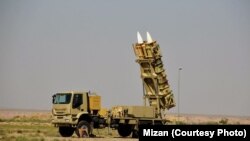Less than a week after U.S. imposed sanctions on Iran for its ballistic missiles tests, Iranian state owned national TV showed off an upgraded version of a home-made air defense missile.
During a ceremony for the mass production launch of the new missile, on Saturday, July 22, Iran’s air defense commander, Brigadier General Farzad Esmaili, said the missile is “a completely indigenous technology.”
However, Iran occasionally announces production of sophisticated homegrown weapons that cannot be independently verified.
The new missile is dubbed as ‘Sayyad-3’ which in Persian means “Hunter-3’
“The Sayyad-3 is designed to be mounted on the mobile version of S-200 air defense system,” said Iran’s Minister of defense, Hossein Dehqan, adding, “Its range is 120 kilometers, (or roughly 75 miles) and is capable of hitting targets at altitudes of up to 27 kilometers (about 17 miles)”.
According to Dehqan, the Sayyad-3 “Flies at an altitude of 16 miles for 74 miles and it is capable of confronting different threats, including stealth fighter-bombers, drones, cruise missiles and helicopters.”
Furthermore, the Sayyad-3 air defense system, Dehqan insists, “Is armed with infrared facility and is capable to engage in electronic warfare.”
In addition to the Sayyad class of surface-to-air missiles, the Islamic republic also possesses the advanced Russian made S-300 air defense system, which it acquired following its July 2015 nuclear deal with world powers.
During the inauguration of Sayyad-3 mass production line, Dehqan implicitly said that the new system is Tehran’s response to the $110 billion arms purchase Saudi Arabia made from the United States, adding that its objective was to "threaten Islamic Iran”.
Reacting to Iran’s missile activities, British Sunday Express reports, “The Israeli Air Force has trained for a scenario in which it would have to carry out strikes in Syria or Iran on facilities defended by the S-300.”
In a 2015 interview, Israeli Air Force commander Maj. Gen. Amir Eshel said the S-300 was a “significant but not insurmountable challenge” for the Israeli Air Force.





